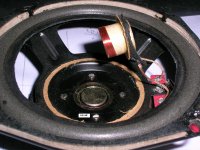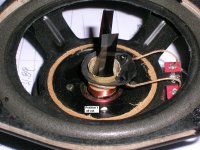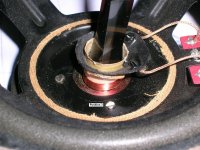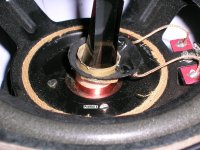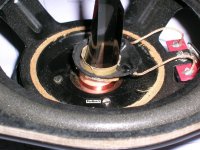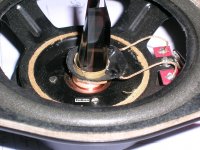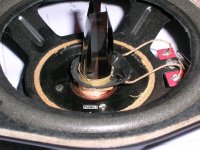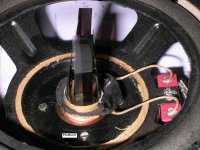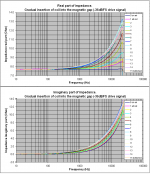For there to be an audible difference, these thing need to exist:Everything is connected together so why shouldn’t a mains filter make an audible difference? At least in principle.
a] There needs to be offending noise on the AC power line.
b] The filter needs to be able to filter the offending noise (most filters don't do this).
c] The audio units need to be poorly designed so that the noise is a problem.
Hi Kevin,
LOL!
Yes, your point c is so true. There has to be a problem that needs fixing before you can fix it.
LOL!
Yes, your point c is so true. There has to be a problem that needs fixing before you can fix it.
Nice, thank you.Here is some data from a cheap 3.8inch cone car driver with a 5.4oz ceramic magnet.
gap height=2.6mm
coil height=3.5mm (slightly overhang)
coil inner diameter=15mm
paper coil former
If there is something else you want me to do with this humble motor, do not hesitate to ask it 🙂
George
PS. For those who can take some more cello work YouTube
So in air, the real is totally flat and resistive. As it goes further into the iron, the resistive loss from eddies gets significant.
And as the coil move in, inductance rises. nice..
I've a whole mess of tests I've thought of, but that's for another day.. for example, if you drive the coil in and out of the gap using a 50 hz mechanical drive, how does the modifying resistance and inductance affect the higher frequency signals? To wit; the 10 k resistance climbs to 10 ohms, so the variation in losses vs mechanical location would cause an amplitude modulation of the 10Khz signal, and that modulation is not symmetrical with location.
jn
Last edited:
Sounds yummy. I have never had baguette french toast nor have I ever come across a sour dough baguette. Is this a local thing? I suppose I could try to make one.
First place I had it baguette style was in Missoula Montana at a little place in the Rattlesnake area.
Trader Joe's has regular sourdough version where I am now. In Missoula it was Le Petit Outre that made it.
The firmness simply makes it better imo. And the sourdough is just something extra. It is easy to handle, too, since the bread isnt super floppy.
I believe the tests you are on the way to do had never been made before. It deserve an article . I believe that what you will discover will be the key of the sound differences we can notice, on the same speaker, between different amps with close performances. The way they deal with back EMF and constantly changing charge's impedances.I've a whole mess of tests I've thought of, but that's for another day.
Last edited:
Thanks for those voice coil measurements. Looks like skin effect when the real component is the same as the imaginary component.
You are welcome.
Through calculation, skin depth (37% of current density of the value at conductor’s surface) even at 22kHz is 0.44mm.
The coil wire is close to 0.2mm diam. Therefore skin effect shouldn’t be an issue with this voice coil. The on air measurement of impedance’s real part should show skin effect and proximity effect.
These measurements at post #4357 of coil on air show only a tinny increase of 0.1Ohm of the real part across the freq range 10Hz to 22kHz. (also real part varies only by 0.01Ohm for 54dB variation of signal level)
Then, when the coil is inside the coil gap at neutral position, the real part of the impedance rises approx 5.5Ohm across 10Hz to 22kHz (also real part varies by 0.3Ohm for 54dB variation of signal level. So these larger variations are to be attributed to the surrounding metal and magnet losses (eddy current mostly)
Yesterday I made a set of impedance measurements while pushing the coil more and more into the gap.
The max possible operational excursion of this coil was +/-2mm (4mm total).
Now I moved it for a travel of 11mm total, (coil 2mm above the magnetic gap to coil 3mm below the magnetic gap).
The real part increases with the coil progressively entering the magnetic gap, becomes maximum with the coil aligned with magnetic gap and starts reducing when coil progresses past the magnetic gap. Same trend seen on imaginary part but there variation is less. See attachments below.
Looks like the motor assembly has about 1.39x the permeability of air. I expected it to be more.
Using the imaginary part of the new measurements, at 1kHz the ratio is 2.51 (1.13Ohm coil centered in the gap / 0.45Ohm coil on air).
Using the LCR meter, the ratio is 2.61 (191uH coil centered in the gap / 73uH coil on air).
What about voicecoil harmonics when locked in place in the gap?
This I may do. But compared to what?
Or inductance vs DC bias?
What will be the practical use of it?
George
Attachments
In Southeast Asia especially the street food rules, that's why I miss my little Thai place ex-pats making cash only street food style.
We lost a lot getting rich and organized and all that.
I don't think that is the case but I hold little prejudice.
You have raised the question, you are part of the solution (and of the problem 😀)Nice, thank you.
for example, if you drive the coil in and out of the gap using a 50 hz mechanical drive, how does the modifying resistance and inductance affect the higher frequency signals.
How can I do this?
Should I feed a driver with a two tone signal (a low freq and a high freq) and check with an FFT the harmonics of the high freq within a cycle of the low freq signal ? (f* difficult)
George
Oh, sorry, gpapag, this message was for you ...I believe the tests you are on the way to do had never been made before. It deserve an article . I believe that what you will discover will be the key of the sound differences we can notice, on the same speaker, between different amps with close performances. The way they deal with back EMF and constantly changing charge's impedances.
Oh it's entirely possible, and the difference might not be for the better. But it's also possible with competently designed equipment it makes no difference at all. And I doubt there will be 'night and day' going on.
It's true, competent design is a critical factor. Even in the professional audio world things are very different from 30 years ago in the days of broadcast-quality equipment with input and/or output transformers and RF filtering and triple-shielded power transformers with separate ground and chassis connection, both separate from signal input and output.
If we are talking about just an AC power line filter, of course the effect will be predicated on a component's PSRR and supply design. However, most competent AC conditioning systems like the Monster ones Richard Marsh designed combine filtering with galvanic isolation to break ground loops which are extremely common in home theater, or any system with ethernet/cable/antenna/AC mains ground connections, or even just with unbalanced RCA signal transport.
I view the combination as being necessary in studio power system design, or at home when using commonly available AV components especially with unbalanced cabling....sort of an all-in-one approach to power issues. These will often make a difference in either sound quality, video quality or both.
Many studios have experienced issues such as a static sound when a janitor was running a vacuum with a universal motor, or home studios when a blender was running in the kitchen above. Filtering and isolation minimize or eliminate these issues.
Just my experience,
Howie
Aligning two speakers one in front of the other with a cartboard tube glued on the menbrans, and feeding one with the 50HZ, while feeding the other with 10KHz and measuring on it ?How can I do this?
Last edited:
Most speaker drivers (but not all) have rising impedance with frequency. So even thou skin effect increase with frequency the ratio of cable impedance to driver impedance doesn't change.
For those few weird loudspeakers (like Apogee and some Martin Logans) that have very low impedance at high frequencies, the cable loop inductance overwhelms the skin effect.
Now if someone were to donate a pair of those weird speakers to me, I would use mono-block amps right behind each speaker with cables less than a meter long.
For those few weird loudspeakers (like Apogee and some Martin Logans) that have very low impedance at high frequencies, the cable loop inductance overwhelms the skin effect.
Now if someone were to donate a pair of those weird speakers to me, I would use mono-block amps right behind each speaker with cables less than a meter long.
Howie: would you not agree though that the use of mains isolation transformers requires an understanding of earthing (particularly safety earthing) beyond that of the level of the general target audience for domestic audio products?
Thinking about it not sure Whitlock mentions them at all. That can't just be because Jensen don't make them? 😛
Thinking about it not sure Whitlock mentions them at all. That can't just be because Jensen don't make them? 😛
Or someone who sells main filters has a vested interest in hearing things that are not there?
Keep dreaming. Now if you said there is a lot of junk conditioners out there, you'd be right.
Think about common mode filtration. Common mode is a problem that circuit design is not very effective in reducing except in signal in/out. The AC enoise will inherently be more parasticly problematic. The ripple filtering caps do almost nothing for whatever enoise comes in. A CRC helps a bit more. But if you really want to get something going on you're talking a voltage regulator. There are circuits that are considerably more immune, but that doesn't mean they are entirely immune; and nor does it mean circuits that are less immune are bad circuits that sound bad.
Also you cannot "filter" in PFC. PFC does absolute wonders for guitar amps. I will even give you an anecdotal story. While I've had a sound guy tell me he had to use way less compression on the guitars while using one.... my favorite instance was at a small metal show at a T-shirt printing store front. This band that lived in a shitty warehouse to svae money, to spend only on music gear, rolled in for their set with amazing equipment like you never see with small touring bands. Massive tube amps on 12/15 x4 cabs and such. Anyway their lead guy was excited to plug into a power conditioner. While they were playing they sounded awesome, the crowd went wild. But what stood out was this one guitar solo in particular, where it sounded like the musician had a lot of extra room to play more, more free space he wasn't using. In sounded nearly strange. After they finished I started talking to the guy, he said everything sounded unusually good. Then I mentioned that it sounded like that one solo may have been different, curious if the extra room was normal or not. He immediately lit up and said, "doood I know EXACTLY which solo you're talking about I've never had that extra room before."
Another fun one, Greg Boyd, who owns a renoun musician instrument shop, specializing in things that cost as much as your car (mostly acoustic), played guitar through one and was rather impressed. I quote, "the splats gone" as his description of what some PFC can do for guitar where the peak of the note is basically flat and therefor not very harmonically rich, without PFC. His employees kind of starred at him confused as they walked by and he was smiling and saying, "the splats gone, the splats gone" to them.
Over some years I have collected way too much anecdotal evidence to ever consider there is a placebo effect. I only make them on request right now, as I haven't fully made a commercializex version or website yet... I will tell you about my first one sold. At the time I was in college. My landlord lived in the garage, and showered in the house in the morning. I had a stereo, was on here and other forums since high school. Landlord was an audiophile I met at a local audiophile store. I made a power conditioner. One day I let him try it out. My roommate began complaining the music sucked, and to go get the conditioner back. I called him and he told me, "call Craig, he had it." A bit annoyed, not knowing who Craig was... I called him and he told me, "Jeremy, this is amazing, I have never listened to so much music. Just build another one for yourself and send me the bill." Well I talked him into building a better one for him, and got my first one back that my dad has now with my college speaker setup for watching movies and TV.
Anywayz. Also over years Kevin (Speedskater) has denounced power conditioning, while I have changed dozens of minds on it. So if you all want to believe it is fooey, feel free to be a loon I guess. That or you can design terrible filters with problems... there are so few out there that are good, it is silly. The only one I consistently recommend is the SurgeX. It isn't a strong filter, but it doesn't have the problems most have. Also it is $100 used on eBay. You cannot go wrong with it.
Oh, sorry, gpapag, this message was for you ...
No, you were right on your first post.
Credit goes to the one thinking over the problem and formulating the question. The brains is John.
It would be nice if someone mastering a magnetics FEA would run a simulation and provide the results.
Oh, thanks Tryphon, brilliant.Aligning two speakers one in front of the other with a cartboard tube glued on the menbrans, and feeding one with the 50HZ, while feeding the other with 10KHz and measuring on it ?
This I can do. The low freq can be very low, so there will be enough of HF content within one LF cycle to analyse
George
Even in the professional audio world things are very different from 30 years ago in the days of broadcast-quality equipment with input and/or output transformers and RF filtering and triple-shielded power transformers with separate ground and chassis connection, both separate from signal input and output.
Howie
Yes, but remember how difficult it was to pass the proof even with those measures in place?
To those not in broadcast, passing the proof in FM was S/N > -60db, and distortion < 0.1%. Not great specs.
Alan
No, you were right on your first post.
Credit goes to the one thinking over the problem and formulating the question. The brains is John.
It would be nice if someone mastering a magnetics FEA would run a simulation and provide the results.
Oh, thanks Tryphon, brilliant.
This I can do. The low freq can be very low, so there will be enough of HF content within one LF cycle to analyse
George
I have not played around with any of the M side of our EM package on COMSOL, but it's going to be a while, if ever, before I could make a decent sim. Something that would massively simplify my life would be a good cross sectional drawing of a driver of interest.
@Destroyer: Lots of Max Headroom level 'Axl said' with not a single graph. Headology at play I'm afraid.
Surge-X is a company/product that arises out of the work of Neil Muncy and Jim Brown. Very accomplished and knowledgeable about mains problems.
here's Neil on grounding from the AES YouTube
Jim Brown has retired and coalesced his publications into one reference page so you have to pick and choose, but lots of good stuff in there. Audio Systems Group, Inc. Publications
Cheers
Alan
here's Neil on grounding from the AES YouTube
Jim Brown has retired and coalesced his publications into one reference page so you have to pick and choose, but lots of good stuff in there. Audio Systems Group, Inc. Publications
Cheers
Alan
- Status
- Not open for further replies.
- Home
- Member Areas
- The Lounge
- John Curl's Blowtorch preamplifier part III
